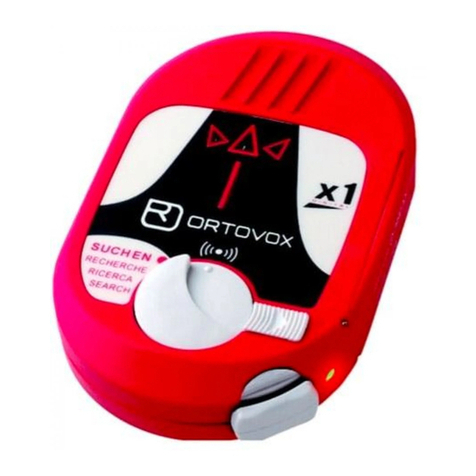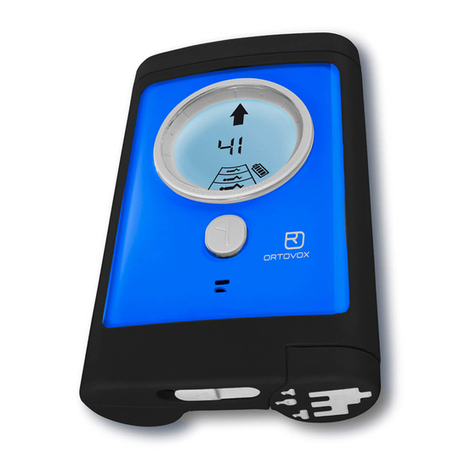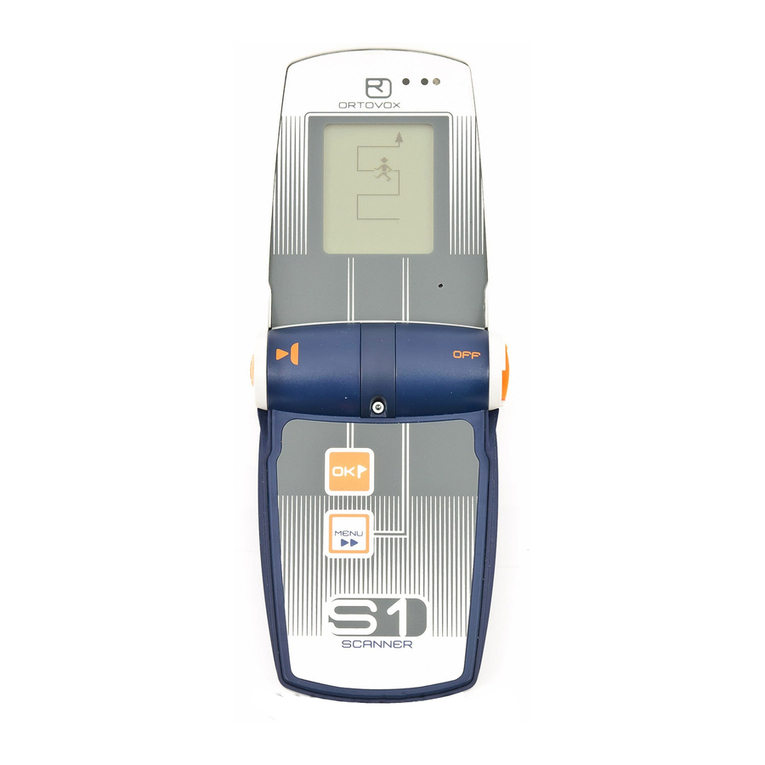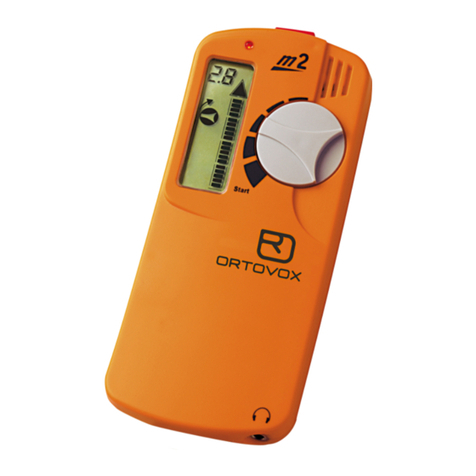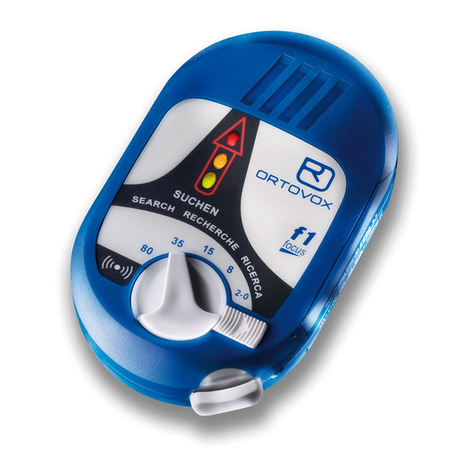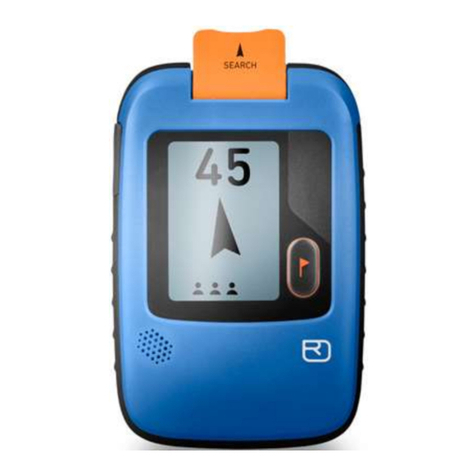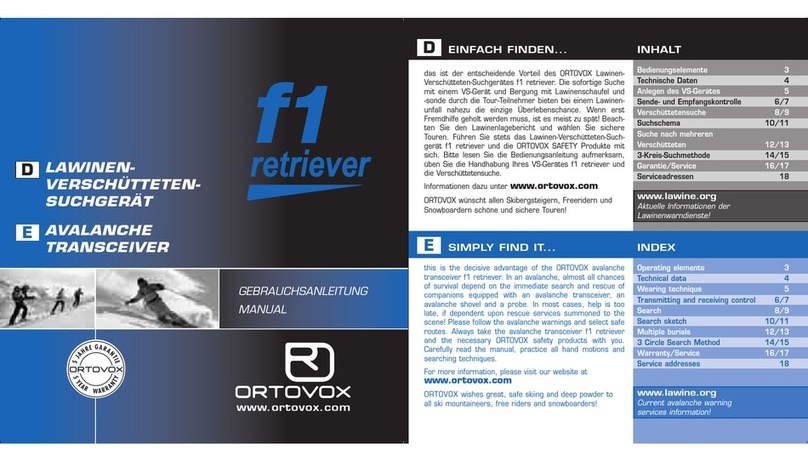OPERATING
ELEMENTS
E
BEDIENUNGSELEMENTE
Optische Suchanzeige
Ohrhöreranschluss
Lautsprecher
Batteriedeckel
Entfernungsskala
für Empfang
Verriegelungs-
Schiebeschalter
Batteriezustands-/
Sendekontroll-Leuchte
Einschaltbajonett
Lautstärkendrehschalter
Sendeposition
1
2
3
4
5
6
7
8
9
10
FUNKTION: analog
GEHÄUSE: ergonomisch, wasserdicht, schlagfest
GRÖSSE: 130 x 80 x 20 mm
FREQUENZ: 457 kHz
REICHWEITE: bis zu 80 m
SUCHSTREIFENBREITE: bis zu 40 m
TEMPERATURBEREICH: -20°C bis +45°C
Sollte das Gerät naß geworden sein, nicht mit Heißluft trocknen.
Durch Heißluft kann das Gerät auch nach Abkühlung einen blei-
benden Funktionsschaden erleiden.
STROMVERSORGUNG:
2 Batterien Alkaline AA LR6 Mignon 1,5 Volt E91 AM3
BETRIEBSDAUER
SENDEN: ca. 350 Stunden
EMPFANGEN: ca. 40 Stunden
GEWICHT: ca. 230 g inkl. Batterien und Tragegurt
Das ORTOVOX f1 focus übertrifft die hohen
Anforderungen der EURO-Norm EN 300 718.
3
2
10
4
7
6
9
1
8
5
FUNCTION: analogue
CASING: ergonomic, waterproof, shock-resistant
DIMENSIONS: 130 x 80 x 20 mm
FREQUENCY: 457 kHz
RANGE: up to 80 m
SEARCH STRIP WIDTH: up to 40 m
TEMPERATURE RANGE: -20°C to +45°C
If your transceiver becomes wet, do not use direct heat, i.e. hair
dryer, to dry it out. Heat applied in such a direct manner may cause
major and lasting damage to your transceiver, regardless of whether
or not the unit is permitted to cool off after such a heat application.
BATTERIES: 2 x 1.5 V alkaline (no rechargeables)
LR6 mignon 1,5 Volt E91 AM3 (2 "AA" batteries)
WORKING LIFE
TRANSMITTING: about 350 h
RECEIVING: about 40 h
WEIGHT: about 230 g incl. batteries and straps
The ORTOVOX f1 focus surpasses the high require-
ments of the European standard EN 300 718.
Visual search indicator
Socket for earplug
Loudspeaker
Battery compart-
ment lid
Scaled display
for search zones
Locking switch
Visual control light for battery
capacity and function control light
Bayonet switch (forced ON/OFF)
Switch for volume control
Transmitting position
1
2
3
4
5
6
7
8
9
10
D
TECHNISCHE DATEN EU-KONFORMITÄTSERKLÄRUNG
EC-DECLARATION OF CONFORMITY
TECHNICAL DATA
Hersteller: X-log Elektronik GmbH
Verantwortliche Person: Herr Nowotny
Bahnhofstr. 95, D-82166 Gräfelfing
erklärt, dass das Produkt: Typ: ORTOVOX
Modell: f1 focus
Verwendungszweck:Lawinenverschüttetensuche
bei bestimmungsgemäßer Verwendung den grundlegenden Anforderungen
gemäß Artikel 3 der R&TTE-Richtlinien 1999/5/EG entspricht und dass
die nachfolgenden Normen angewandt wurden:
1. Gesundheit (Artikel 3.1.a der R&TTE-Richtlinien):
Angewandte Norm(en): ETS 300718 Ausgabe: 05/01
2. Sicherheit (Artikel 3.1.a der R&TTE-Richtlinien):
Angewandte Norm(en): ETS 300718 Ausgabe: 05/01
3. Elektromagnetische Verträglichkeit
(Artikel 3.1.b der R&TTE-Richtlinien):
Angewandte Norm(en): ETSI EN 300718-1 Ausgabe: 05/01
4. Effiziente Nutzung des Funkfrequenzspektrums
(Artikel 3.2 der R&TTE-Richtlinien):
Angewandte Norm(en): ETSI EN 300718-2 Ausgabe: 05/01
5. Elektromagnetische Verträglichkeit und Funkspektrumsangelegenheiten
(Artikel 3.3.e der R&TTE-Richtlinien)
Angewandte Norm(en): ETSI EN 300718-3 Ausgabe: 02/04
Gräfelfing, 24.04.2006 i. A. Andrea Reintges
(Ort/Datum der Konformitätserklärung) (Name)
Manufacturer: X-log Elektronik GmbH
Responsible person: Mister Nowotny
Bahnhofstr. 95, D-82166 Gräfelfing
declares that the product: type: ORTOVOX
model: f1 focus
intended use: Search for avalanche victims
complies with the essential requirements of Article 3 of the R&TTE
1999/5/EC Directive, if used for its intended use and that the following
standards have been applied:
1. Health (Article 3.1.a of the R&TTE Directive):
Applied standard(s): ETS 300718 issue: 05/01
2. Safety (Article 3.1.a of the R&TTE Directive):
Applied standard(s): ETS 300718 issue: 05/01
3. Electromagnetic compatibility
(Article 3.1.b of the R&TTE Directive):
Applied standard(s): ETSI EN 300718-1 issue: 05/01
4. Efficient use of the radio frequency spectrum
(Article 3.2 of the R&TTE Directive):
Applied standard(s): ETSI EN 300718-2 issue: 05/01
5. Electromagnetic compatibility and Radio spectrum Matters (ERM)
(Article 3.3.e of the R&TTE Directive):
Applied standard(s): ETSI EN 300718-3 issue: 02/04
Gräfelfing, 24.04.2006 i. A. Andrea Reintges
(Place/date of the declaration of conformity) (Name)
